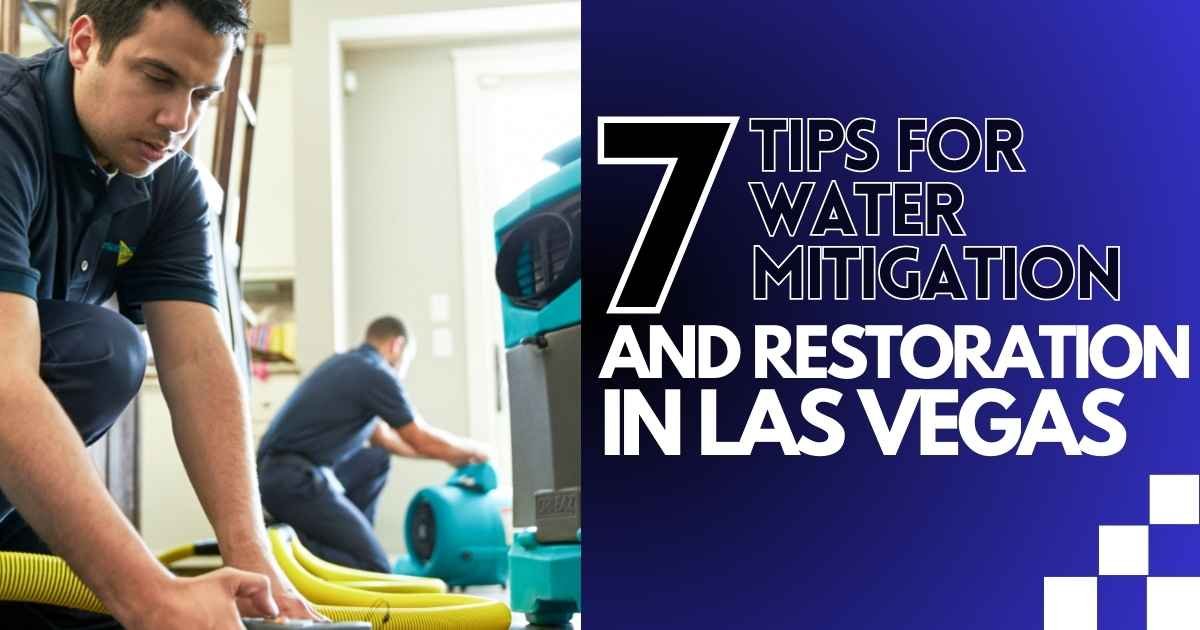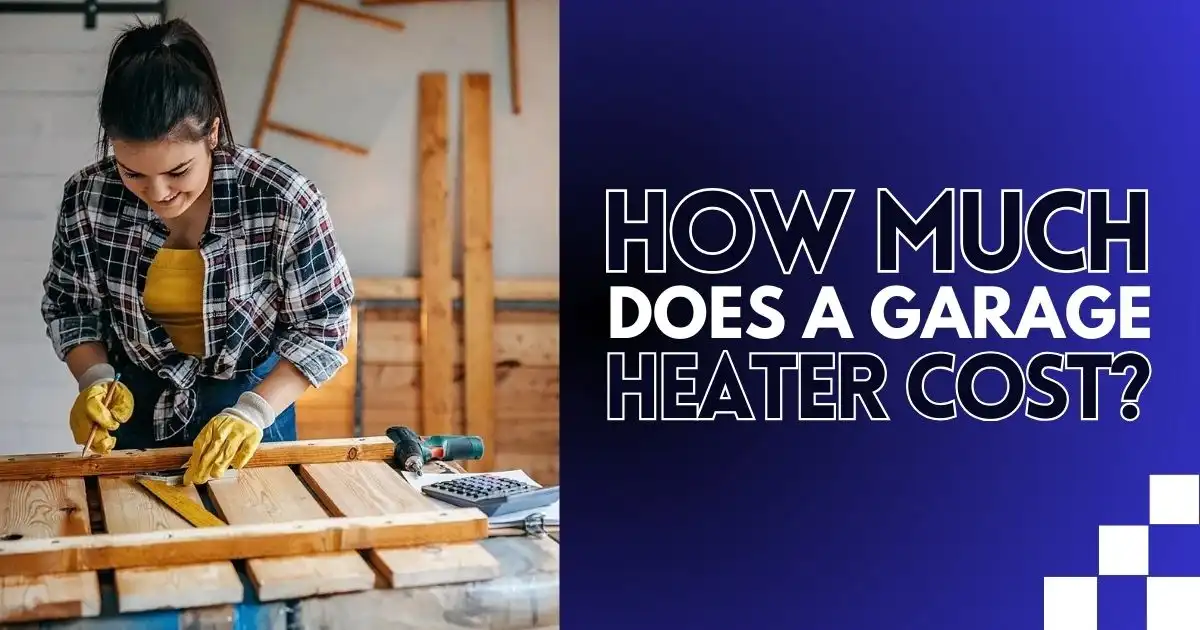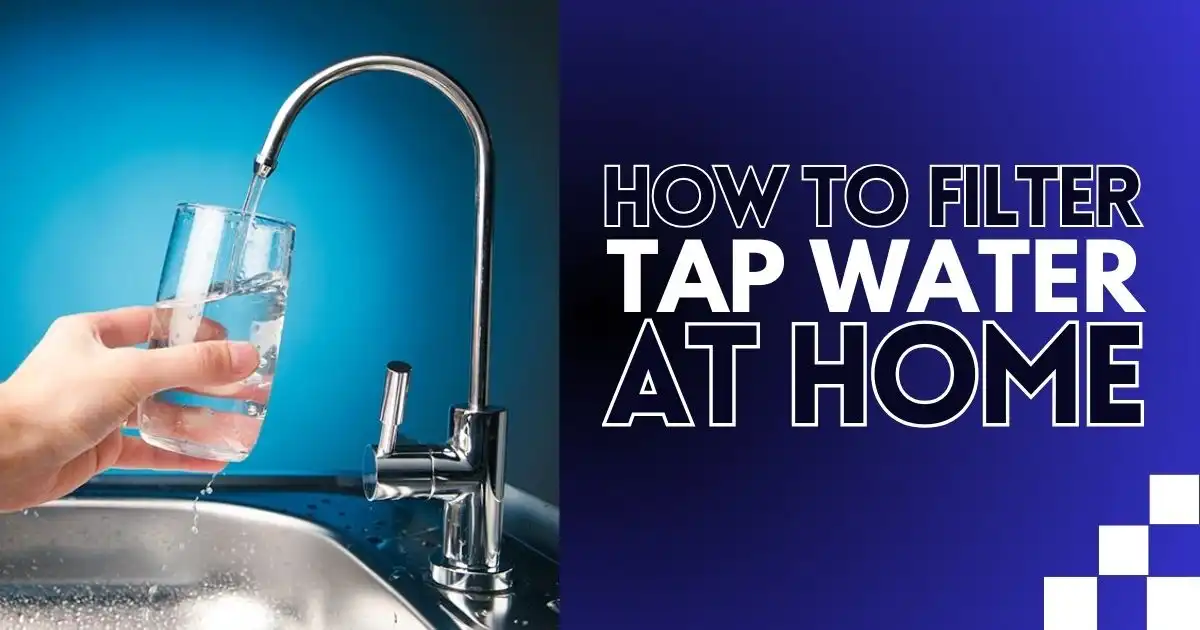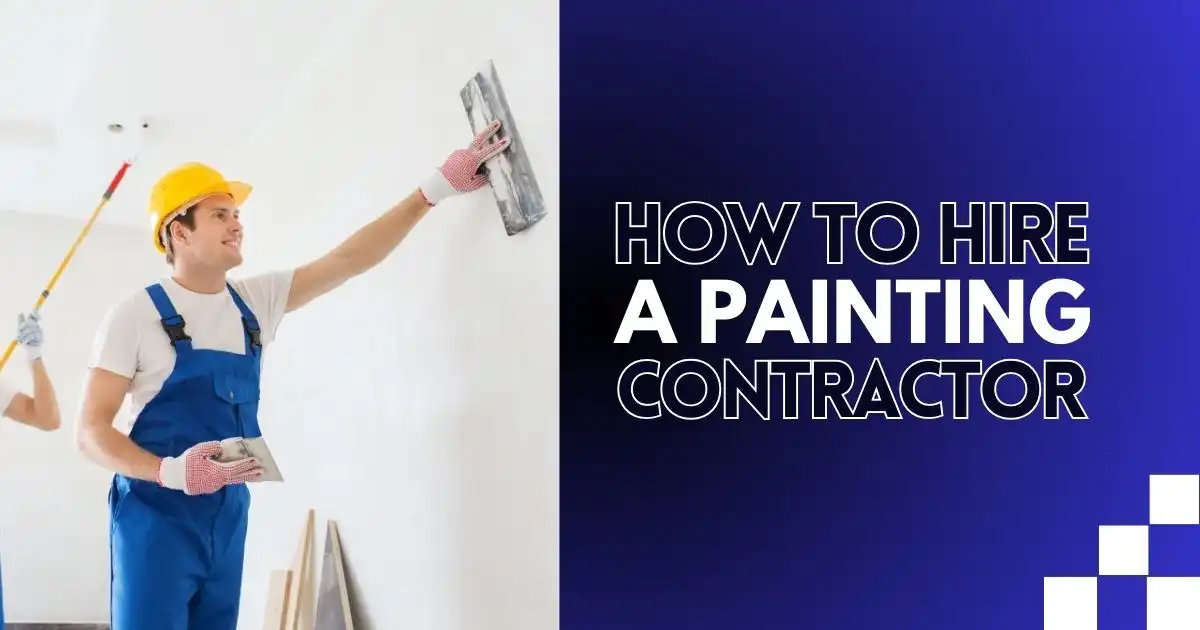What would you do if your safe place suddenly started sinking under a rising tide of water damage?
Just like an unexpected storm, a burst pipe or leaky roof can quickly turn your home into a chaotic mess. Water damage isn’t just about wet floors—it can weaken your walls, cause mold to grow, and lead to serious health risks. If left unchecked, even a small leak can turn into a big, costly problem.
Water Damage and Its Consequences
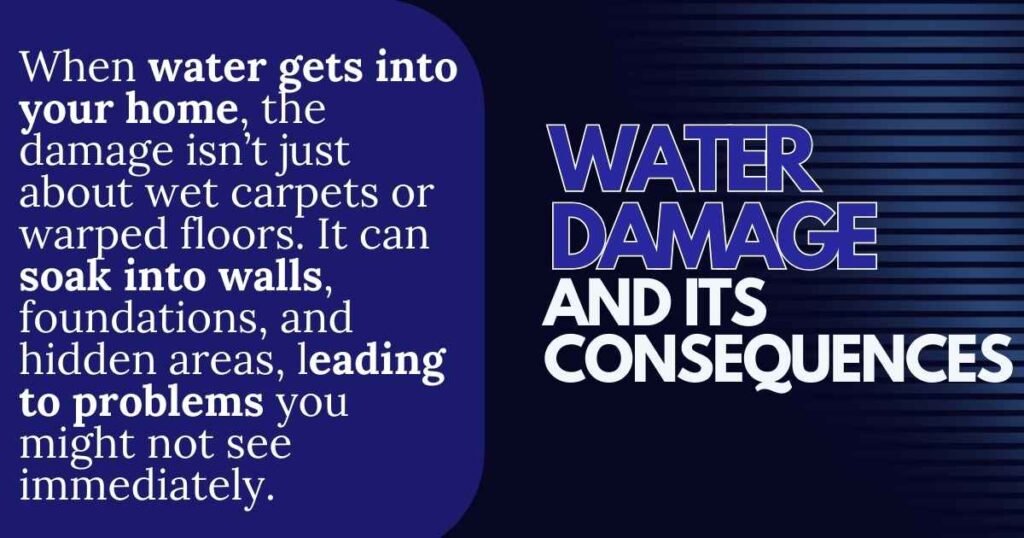
In Las Vegas, when water gets into your home, the damage goes beyond just wet carpets or warped floors. It can seep into walls, foundations, and hidden spaces, leading to problems you might not notice right away. Over time, this moisture can weaken your home’s structure, causing mold, wood rot, and even cracks in your foundation. Proper home water damage cleanup is important to address these risks.
Mold not only harms your property but can also pose health risks, especially for those with allergies or breathing issues. Water restoration is important because water can also seep into electrical systems, increasing the risk of short circuits or fires.
Mitigation vs. Restoration
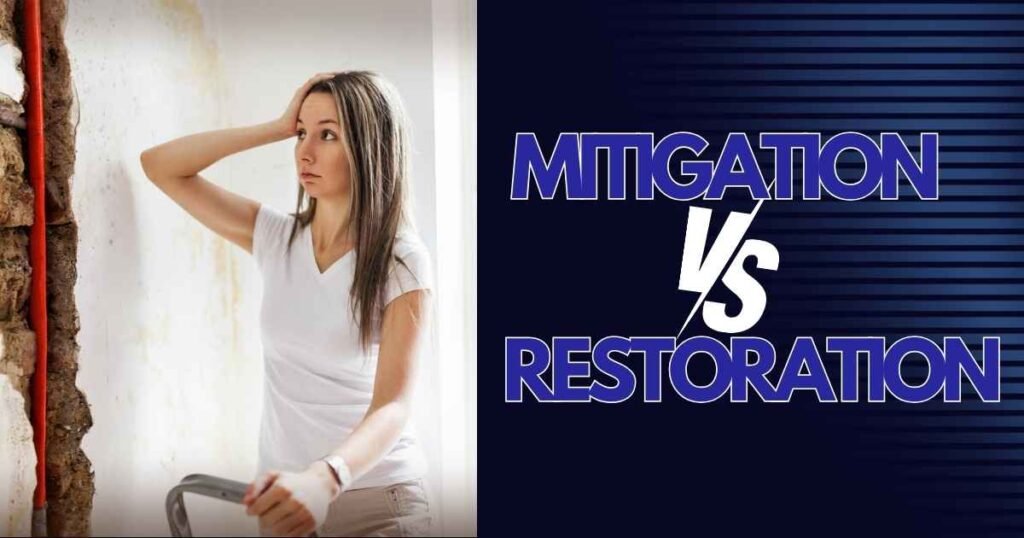
Mitigation is the first step taken to control water damage and stop it from getting worse. This includes tasks like finding and fixing the source of the water, removing standing water, and setting up fans and dehumidifiers to dry the area. The main goal of mitigation is to reduce immediate damage and prevent further problems like mold.
Restoration, on the other hand, is the process of fully repairing and rebuilding the property to its original condition. This involves cleaning, fixing, or replacing damaged parts and ensuring the structure is safe and sturdy again. The restoration phase focuses on making your home safe, functional, and looking good as it was before the damage happened.
7 Tips for Quick Water Damage Recovery & Restoration
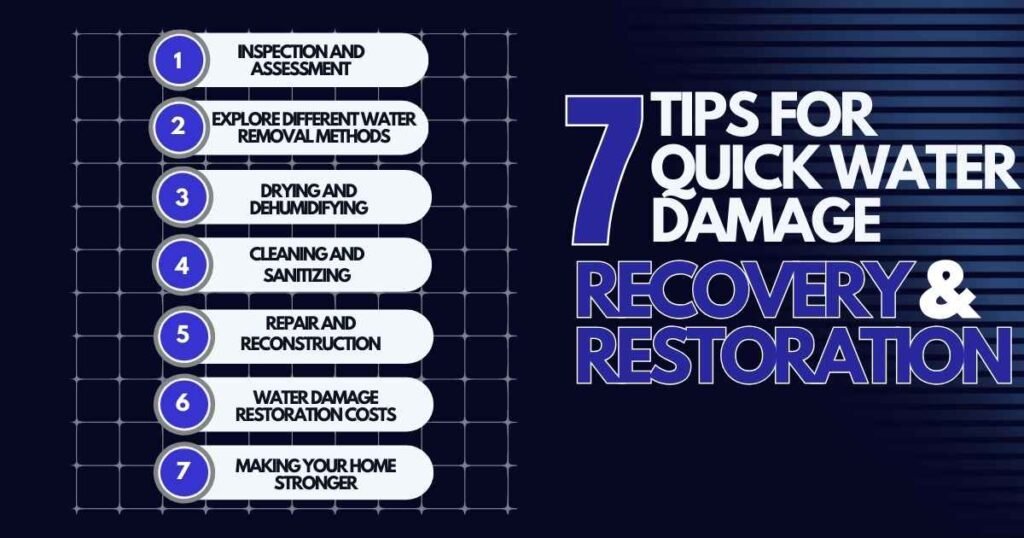
Water damage restoration is a step-by-step process to restore your property after a water disaster, bringing it back to a safe and livable condition.
In Las Vegas, where sudden storms or plumbing issues can cause unexpected flooding, the first step is to find and stop the source of water. Removing water and drying out the area quickly is important to avoid mold and further damage to your home’s structure. Always prioritize safety and reach out for professional help if needed to ensure the job is done right.
1. Inspection and Assessment
A careful inspection is key for successful water damage restoration. This step includes checking how severe the damage is, identifying affected areas, and creating a plan for the restoration process.
Here’s a Simple Water Damage Restoration Checklist:
- Remove Excess Water: Use pumps or towels to get rid of standing water and make sure the area drains properly to prevent more pooling.
- Dry Affected Areas: Use dehumidifiers and fans to speed up drying. Regularly check humidity levels to track progress.
- Clean and Disinfect Surfaces: Thoroughly clean surfaces to remove dirt and apply disinfectants to prevent mold and bacteria.
- Repair or Replace Damaged Materials: Check walls, floors, ceilings, and other structural parts for damage. Repair or replace anything that’s been affected.
- Watch for Mold Growth: Keep an eye out for mold, such as musty smells or visible spots. Address mold issues right away using the correct methods.
- Ensure Proper Ventilation: Maintain good airflow during restoration. Use fans and open windows (if possible) to help with drying.
- Reassess for Missed Damage: Do a final check to ensure everything has been restored properly. Handle any overlooked damage to avoid future problems.
- Document for Insurance Claims: Keep records of the damage, repairs, and costs. Save receipts and communications with insurance providers for claim processing.
2. Explore Different Water Removal Methods
There are various ways to remove water, from basic methods like using pumps or siphoning, to more advanced options like filtration systems and desalination. Understanding these techniques can help you choose the best solution for your needs.
It’s important to get rid of standing water quickly to avoid more damage. Using pumps, vacuums, and other advanced equipment speeds up the process, making the restoration more efficient and thorough.
3. Drying and Dehumidifying
To speed up the drying process, try opening windows and doors to improve natural airflow. You can also place strong fans around the damp areas to help replace moist air with dry, fresh air. Running a dehumidifier will further help by pulling excess moisture from the air.
Here are three top dehumidifiers that can assist with drying:
- Midea 50 Pint Cube Dehumidifier: The Midea 50 Pint Cube has a unique lift-and-twist design for more flexibility. It’s great for large areas up to 4,500 square feet and has a larger water tank than most dehumidifiers. This means it can run longer without needing frequent emptying.
- Levoit LV600S Smart Hybrid Ultrasonic Humidifier: The Levoit LV600S is powerful, quiet, and easy to clean. It has Wi-Fi connectivity and offers a warm-mist option, making it very convenient. It’s designed to avoid over-humidifying, which is rare for ultrasonic models.
- Dreo HM311S Smart Humidifier: The Dreo HM311S is a simple humidifier with smart-home features and a built-in night light. It’s another ultrasonic model that prevents over-humidification, offering ease of use and good functionality.
4. Cleaning and Sanitizing
After surfaces have dried, it’s important to clean and sanitize them to get rid of bacteria and mold spores, keeping the environment safe and healthy for everyone. Household cleaners can effectively remove dirt left behind after a flood, while disinfectants help stop the spread of harmful germs brought in by the water.
Using powdered or liquid cleaners instead of aerosol products is often more practical and budget-friendly, especially when cleaning large areas. To save money, consider buying cleaners and disinfectants in bulk. However, it’s important to make sure the products are suitable for your needs, so always check the label for proper usage instructions before applying them.
5. Repair and Reconstruction
The repair process can involve anything from small fixes to major rebuilding, depending on how bad the damage is. Safety should always come first when repairing and reconstructing after water damage. Start by carefully checking the area for any hazards, like live electrical wires or weakened structures that might be corroded. Deal with these dangers right away to reduce safety risks.
Focus first on the serious damages that need urgent attention before handling minor repairs. For instance, water-damaged ceilings are at high risk of weakening and possibly collapsing because of the pull of gravity. Addressing the most critical safety issues first, you can make the overall repair and reconstruction process smoother and safer.
6.Water Damage Restoration Costs
The cost of water damage restoration can vary depending on factors like the extent of the damage, the type of repairs needed, and the professional services you choose. It’s important to be prepared for unexpected expenses and focus on doing a complete restoration to keep your property stable in the long run. Costs can also differ based on the type and severity of the damage and where it occurs.
When water enters your property, acting quickly is key to avoiding bigger problems like mold or structural issues. In most cases, getting help from a water damage restoration expert is recommended.
Here’s an idea of what water damage repair typically costs:
- Average: $3,300
- High end: $13,000
- Low end: $450
7. Making Your Home Stronger
Improving your home’s ability to withstand water damage by upgrading materials and reinforcing weak spots is a smart investment. These upgrades can help you avoid future problems and may even lower your insurance costs.
For instance, adding better insulation in your attic can prevent ice dams, while upgrading your roofing can protect against fire and severe weather, also boosting energy efficiency.
In Las Vegas, resilient home upgrades like flood prevention systems and energy-efficient features can boost property value by 2% to 5%. Enhancements such as improved insulation and structural reinforcements not only increase safety but also reduce utility costs, making your home more attractive to buyers.
Additionally, Zillow reports that replacing your roof can make it more likely for you to sell at your full asking price and reduce the time your house stays on the market.
The Importance of Acting Quickly on Water Damage
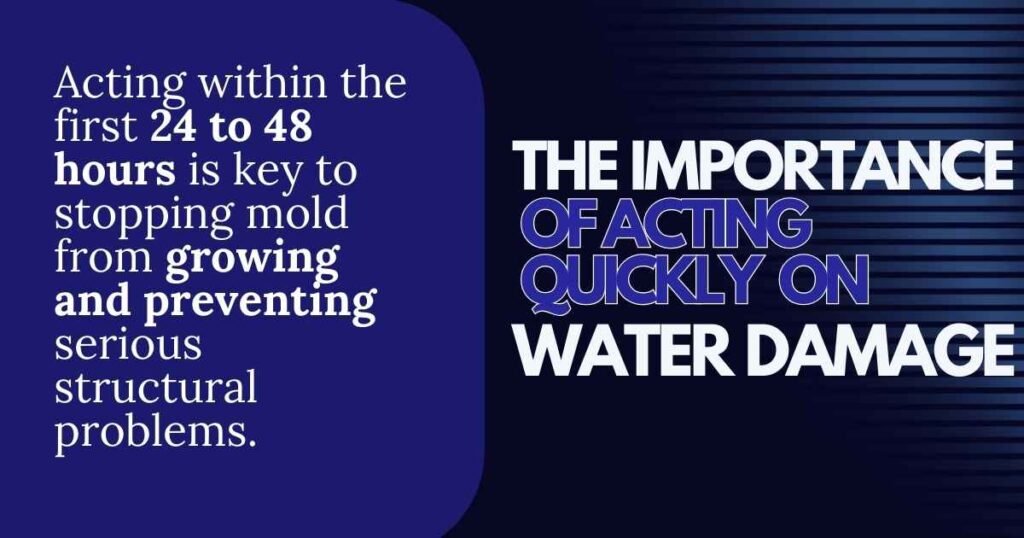
Time is everything when it comes to water damage. The longer water stays, the more damage it causes. Acting within the first 24 to 48 hours is key to stopping mold from growing and preventing serious structural problems.
Quickly removing the water, drying the area, and reducing humidity are critical steps to speed up recovery and limit damage. The sooner you take action, the better your chances of fully restoring your home.
When to Call a Professional

It’s best to call a professional water damage service, like Vegas Plumbing Pros, when the water damage is extensive or if your safety might be at risk. For example, if water has soaked into walls, flooded multiple rooms, or reached electrical outlets, trying to handle it yourself can be dangerous. Professionals have the experience, tools, and specialized equipment to fully assess the situation, remove hidden moisture, and prevent long-term issues like mold or structural damage.
They can also help with insurance claims, making the process less stressful for you. It could be a burst pipe, storm damage, or unexpected flooding—professionals ensure your home is restored safely and efficiently. Reach out to us for fast, reliable water damage service when you need it most.
Safeguard Your Home, Preserve Your Peace
Just like reinforcing the foundation of a home, taking proactive steps for water mitigation and restoration safeguards not only your property but also your peace of mind. While water damage can strike unexpectedly, being prepared and informed ensures that the impact is minimized and recovery is swift.
Staying vigilant, acting quickly, and relying on professional help when needed, you protect what truly matters—your home and well-being. In the end, it’s not just about fixing what’s broken, but about preserving the place where memories are made and lives are built.
FAQs
How long does water damage restoration take?
The time it takes to fix water damage depends on how bad the damage is and what materials are affected. Usually, professional restoration can take anywhere from a few days to a few weeks to fully restore your home.
What are the steps to recover from water damage?
Recovering from water damage starts with quickly assessing the damage, removing any standing water, drying the area, and cleaning it. For more serious damage, it’s best to call a professional water damage restoration service for expert help.
What is the most common cause of water damage?
The most common cause of water damage in homes is plumbing issues, such as burst pipes, leaking faucets, or broken appliances like water heaters and washing machines. In such cases, timely water leak restoration is essential to prevent further damage and costly repairs.
How to avoid water damage after a leak?
Start by shutting off the water to stop the leak. Quickly remove standing water and dry the area with fans and towels. Check for hidden moisture in walls and floors to avoid mold. If needed, remove or replace wet carpets or drywall. For serious damage, call a professional for help.
